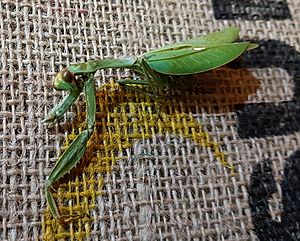Stagmatoptera binotata facts for kids
Quick facts for kids Stagmatoptera binotata |
|
|---|---|
 |
|
| Scientific classification | |
| Synonyms | |
|
Stagmatoptera binotata is a cool type of praying mantis. These amazing insects are part of the Mantidae family. They are known for their special front legs. These legs are often held in a way that looks like they are praying. This is how they got their common name, "praying mantis."
Contents
What is a Praying Mantis?
Praying mantises are insects. They are famous for their unique hunting style. They are predators, meaning they hunt other insects. There are over 2,400 different kinds of mantises. They live all over the world. Most mantises live in warmer, tropical areas.
How They Hunt
Mantises are masters of disguise. They often blend in with their surroundings. This helps them hide from both predators and prey. They can be green, brown, or even look like flowers. They wait very still for their prey to come close. When an insect gets near, they quickly snatch it. They use their strong, spiky front legs to grab and hold their meal.
What They Eat
Stagmatoptera binotata, like other mantises, mostly eats other insects. Their diet can include flies, crickets, grasshoppers, and moths. Some larger mantises can even catch small lizards or frogs. They are very good at catching their food.
Life Cycle of a Mantis
The life cycle of a mantis has three main stages. These stages are egg, nymph, and adult.
Eggs
Female mantises lay their eggs in a special case. This case is called an ootheca. The ootheca is a foamy, protective shell. It hardens over time. It keeps the eggs safe from bad weather and other animals. A single ootheca can hold hundreds of tiny eggs.
Nymphs
When the eggs hatch, tiny mantises emerge. These young mantises are called nymphs. They look like small versions of adult mantises. Nymphs grow by shedding their outer skin. This process is called molting. They molt several times as they get bigger. Each time they molt, they grow a little more.
Adults
After their final molt, nymphs become adult mantises. Adult mantises are fully grown. They can now reproduce. Many adult mantises have wings. This allows them to fly and find mates. The lifespan of a mantis can vary. It depends on the species and where they live. Most mantises live for about six months to a year.
Reproduction
Mantis reproduction is quite interesting. The male mantis must be careful when approaching a female. Female mantises are known to sometimes eat the male. This usually happens after mating. It provides the female with extra nutrients for her eggs.
Finding a Mate
Male mantises often use their wings to fly. They search for females. Females usually release special scents. These scents help males find them. Once a male finds a female, they will mate.
Laying Eggs
After mating, the female mantis will look for a safe place to lay her ootheca. She attaches it to a branch, a stem, or a wall. The ootheca protects the future generation. It ensures the survival of the species.
Where Stagmatoptera binotata Lives
Stagmatoptera binotata was first described in 1869. This means scientists first officially named it then. Like many mantis species, it likely lives in warm climates. Mantises are found on every continent except Antarctica. They prefer places with lots of plants. This helps them hide and find food.
See also
 In Spanish: Stagmatoptera binotata para niños
In Spanish: Stagmatoptera binotata para niños
- List of mantis genera and species

